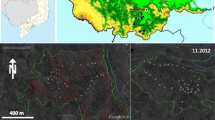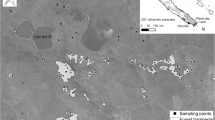Abstract
The northern karst of Puerto Rico is a unique formation that contains one of the island’s largest remaining forested tracts. The region is under ever-increasing human pressure, but large portions of it are being considered for conservation. Forest classification of the region is at a coarse scale, such that it is considered one vegetation type. We asked whether there were distinct tree assemblages which would necessitate targeted conservation strategies to ensure their protection. We examined tree species and communities across the region at three different major topographic positions along mogotes, or haystack-shaped hills. We found distinct tree communities on hilltops and valleys, with significantly more non-native species in valleys and significantly more endemic species on hilltops and hillsides. At a landscape level, we identified at least four different communities within each topographic position. Two mogote top communities were separated geographically (west and south) within the region, while two others co-occurred in the east-central part of the region. Mogote side and valley communities were less distinct geographically. Temperature, elevation, and precipitation were important variables in separating some communities, suggesting that abiotic stress may play an important role in the distribution of some species. In contrast, the lack of geographic separations of other communities suggested that variables such as soil conditions, land use and biotic interactions such as dispersal limitation may also be important. Conservation planning strategies should target the south, west, and east-central areas that harbor distinct mogote top plant communities to ensure protection of the widest range of tree species and communities in the karst region.
Similar content being viewed by others
References
Acevedo-Rodriguez P, Axelrod FS (1999) Annotated checklist for the tracheophytes of Río Abajo forest reserve, Puerto Rico. Caribb J Sci 35:265–285
Aide TM, Zimmerman JK, Pascarella JB, Marcano-Vega LRH (2000) Forest regeneration in a chronosequence of tropical abandoned pastures: implications for restoration ecology. Restor Ecol 8:328–338
Alvarez-Ruiz M, Acevedo-Rodriguez P, Vázquez M (1997) Quantitative description of the structure and diversity of the vegetation in the limestone forest of Río Abajo, Arecibo-Utuado, Puerto Rico. Acta Cient 11:21–66
Asprey GF, Robbins RG (1953) The vegetation of Jamaica. Ecol Monogr 23:359–412
Barnosky AD, Hadly EA, Maurer BA, Christie MI (2001) Temperate terrestrial vertebrate faunas in North and South America: Interplay of ecology, evolution, and geography with biodiversity. Conserv Biol 15:658–674
Birdsey RA, Weaver PL (1987) Forest area trends in Puerto Rico. U.S. Forest Service Resource Note SO-331, New Orleans, Louisiana
Brewer SW, Rejmánek M, Webb MAH, Fine PVA (2003) Relationships of phytogeography and diversity of tropical tree species with limestone topography in southern Belize. J Biogeogr 30:1669–1688
Brooks T, Da Fonesca GAB, Rodrigues ASL (2004) Species, data, and conservation planning. Conserv Biol 18:1682–1688
Chinea JD (1980) The forest vegetation of the limestone hills of northern Puerto Rico. Dissertation Cornell University, Ithaca NY
Chinea JD (2002) Tropical forest succession on abandoned farms in the Humacao Municipality of eastern Puerto Rico. For Ecol Manage 167:195–207
Chinea JD, Helmer EH (2003) Diversity and composition of tropical secondary forests recovering from large-scale clearing: results from the 1990 inventory in Puerto Rico. For Ecol Manage 180:227–240
Clark DB, Clark DA, Read JM (1998) Edaphic variation and the mesoscale distribution of tree species in a neotropical rain forest. J Ecol 86:101–112
Cracraft J (1985) Biological diversification and its causes. Ann Missouri Bot Garden 72:794–822
Curtis JT, McIntosh RP (1951) An upland forest continuum in the prairie-forest border region of Wisconsin. Ecology 32:476–496
Daly C, Helmer EH, Quiñones M (2003) Mapping the climate of Puerto Rico, Vieques and Culebra. Int J␣Climatol 23:1359–1381
Dansereau P (1966) Studies on the vegetation of Puerto Rico. I. Description and integration of the plant-communities. Institute of Caribbean Science Special Publication No. 1, Mayagüez, Puerto Rico
Dinerstein E, Olson AM, Graham DJ, Webster AL, Primm SA, Bookbinder MP, Ledec G (1995) A conservation assessment of the terrestrial ecoregions of Latin America and the Caribbean. The World Bank, Washington, DC
Dufrêne M, Legendre P (1997) Species assemblages and indicator species: the need for a flexible asymmetrical approach. Ecol Monogr 67:345–366
Ferrier S (2002) Mapping spatial pattern in biodiversity for regional conservation planning: Where to from here? Syst Biol 51:331–363
Foster DR, Fluet M, Boose ER (1999) Human or natural disturbance: landscape-scale dynamics of the tropical forests of Puerto Rico. Ecol Appl 9:555–572
Foster DR, Swanson F, Aber J, Burke I, Brokaw N, Tilman D, Knapp A (2003) The importance of land-use legacies to ecology and conservation. BioScience 53:77–88
Francis JK, Lowe CA (2000) Silvics of native and exotic trees of Puerto Rico and the Caribbean Islands. USDA Forest Service Technical Report IITF-15, Rio Piedras, PR
Franco PA, Weaver PL, Eggen-McIntosh S (1997) Forest resources of Puerto Rico, 1990. Resource Bulletin SRS-22. U.S.D.A. Forest Service, Southern Research Station, Asheville, NC
Gentry AH (1992) Tropical forest biodiversity—distributional patterns and their conservational significance. Oikos 63:19–28
Grau HR, Aide TM, Zimmerman JK, Thomlinson JR, Helmer EH, Zou X (2003) The ecological consequences of socioeconomic and land-use changes in postagriculture Puerto Rico. Bioscience 53:1159–1168
Groves C, Valutis L, Vosick D, Neely B, Wheaton K, Touval J, Runnels B (2000) Designing a geography of hope: a practitioner’s handbook for ecoregional conservation planning. The Nature Conservancy, Washington DC
Helmer EH, Ramos OR, López TM, Quiñones M, Diaz W (2002) Mapping forest type and land cover of Puerto Rico, a component of the Caribbean biodiversity hotspot. Caribb J Sci 38:165–183
Legendre P, Legendre L (1998) Numerical ecology. Elsevier Science, New York
Liogier HA, Martorell LF (2000) Flora of Puerto Rico and adjacent islands: a systematic synopsis, 2nd ed. Editorial de La Universidad de Puerto Rico, San Juan
Little EL, Woodbury RO, Wadsworth FH (1988) Arboles de Puerto Rico y Los Islas Virgenes, vol 2. U.S. Department of Agriculture, Washington DC
Lugo AE, Schmidt R, Brown S (1981) Tropical forests in the Caribbean. Ambio 10:318–324
Lugo AE, Brown S (1999) Biodiversity in the Caribbean: management and benefits. In: Yocum C, Lugo AE (eds) Proceedings of the ninth meeting of Caribbean foresters at the Dominican Republic, June 1–5, 1998. USDA Forest Service, International Institute of Tropical Forestry, Rio Piedras, PR
Lugo AE, Castro LM, Vale A, López TdM, Prieto, EH, Martinó AG, Rolón ARP, Tossas AG, McFarlane DA, Miller T, Rodríguez A, Lundberg J, Thomlinson J, Colón J, Schellekens JH, Ramos O, Helmer E (2001) Puerto Rican Karst-A Vital Resource. USDA Forest Service, San Juan, PR
Lugo AE, Helmer E (2004) Emerging forests on abandoned land: Puerto Rico’s new forests. For Ecol Manage 190:145–161
Marcano-Vega H, Aide TM, Báez D (2002) Forest regeneration in abandoned coffee plantations and pastures in the Cordillera Central of Puerto Rico. Plant Ecol 161:75–87
Martin TE, Hochachka W, Conway CJ, Jenkins JW (1996) BBIRD field protocol. Montana Cooperative Wild-life Research Unit, University of Montana, Missoula, Montana
McCune B, Grace JB (2002) Analysis of ecological communities. MjM Software Design, Gleneden Beach, Oregon
McCune B, Mefford MJ (1999) PC-ORD. Multivariate analysis of ecological data, Version 4. MjM Software Design, Gleneden Beach, Oregon
Meyers N, Mittermeier RA, Mittermeier CG, da Fonesca GAB, Kent J (2000) Biodiversity hotspots for conservation priorities. Nature 403:853–858
Monroe WH (1976) The karst landforms of Puerto Rico. United States Geological Survey, Washington DC
Moritz C (2002) Strategies to protect biological diversity and the evolutionary processes that sustain it. Syst Biol 51:238–254
Muller-Landau H, Wright JP, Calderon O, Hubbell SP, Foster RB (2002) Assessing recruitment limitation: concepts, methods, and case-studies from a tropical forest. In: Levey DJ, Silva WR, Galetti M (eds) Seed dispersal and frugivory: ecology, evolution, and conservation. CAB International, Oxon, pp 35–54
Oliver I, Holmes A, Dangerfield JM, Gillings M, Pik AJ, Britton DR, Holley M, Montgomery ME, Raison M, Logan V, Pressey RL, Beattie AJ (2004) Land systems as surrogates for biodiversity in conservation planning. Ecol Appl 14:485–503
Proctor GR (1986) Cockpit country and its vegetation. In: Thompson, DA, Bretting PK, Humphreys M (eds) Forests of Jamaica. Jamaican Society of Scientists and Technologists, Kingston, Jamaica, pp 43–47
Rivera LW, Aide TM (1998) Forest recovery in the karst region of Puerto Rico. For Ecol Manage 108:63–75
Rivera LW, Zimmerman JK, Aide TM (2000) Forest recovery in abandoned agricultural lands in a karst region of the Dominican Republic. Plant Ecol 148:115–125
Rosenzweig ML (1995) Species diversity in space and time. Cambridge University Press, New York NY
Sarkar S, Margules C (2002) Operationalizing biodiversity for conservation planning. J Biosci 27:299–308
Stohlgren TJ, Binkley D, Chong GW, Kalkhan MA, Schell LD, Bull KA, Otsuki Y, Newman G, Bashkin M, Son Y (1999) Exotic plant species invade hot spots of native plant diversity. Ecol Monogr 69:25–46
Trejo-Torres JC, Ackerman JD (2002) Composition patterns of Caribbean limestone forests: are parsimony, classification, and ordination analyses congruent?. Biotropica 34:502–515
Whittaker RJ, Willis KJ, Field R (2001) Scale and species richness: towards a general, hierarchical theory of species diversity. J Biogeogr 28:453–470
Wiens JA (1989) Spatial scaling in ecology. Funct Ecol 3:385–397
Acknowledgements
We would like to thank Mathilde Julien, Adrián Jordán, Nina Craig, Ana Trujillo, J.C. Trejo Torres, J. Sustache, M. Vives, E. Font, and Emma for help in the field; William Gould, Brooke Edwards and Olga Ramos for GIS assistance; T. Brandeis,W. Gould, M. Kappelle, A. Lugo, G. McPherson, E. Medina, T. Wentworth, and two anonymous reviewers for comments on the manuscript. This work was supported by the Puerto Rico Department of Natural Resources (Federal Aid Project W-23), a David H. Smith Conservation Research Fellowship, The Nature Conservancy, the International Institute of Tropical Forestry GIS and Remote Sensing Laboratory, North Carolina State University, the University of Puerto Rico, the UPR Botanical Garden Herbarium, and W. Gould and E.␣Santiago-Valentín.
Author information
Authors and Affiliations
Corresponding author
Rights and permissions
About this article
Cite this article
Aukema, J.E., Carlo, T.A. & Collazo, J.A. Landscape assessment of tree communities in the northern karst region of Puerto Rico. Plant Ecol 189, 101–115 (2007). https://doi.org/10.1007/s11258-006-9169-5
Received:
Accepted:
Published:
Issue Date:
DOI: https://doi.org/10.1007/s11258-006-9169-5




